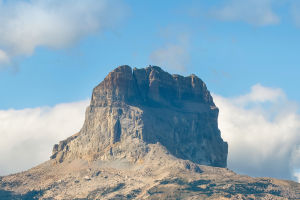Sandstone is a sedimentary rock formed from sand-sized grains of mineral, rock, or organic material that have been compacted and cemented together over time. Sandstone landforms are geological features that have been shaped by erosion, weathering, and other natural forces acting on sandstone formations.
Sandstone landforms are commonly found in arid or semi-arid regions where the rock is exposed to wind and water erosion. These features can range in size from small outcroppings to large plateaus and can take on a variety of shapes, including canyons, arches, spires, and hoodoos.
Canyons are one of the most common sandstone landforms, and they are formed by the erosion of sandstone by water. As water flows over the surface of the rock, it gradually wears away the softer layers, creating a channel that can grow deeper and wider over time. The result is a narrow, steep-sided gorge with towering walls of sandstone.
Arches are another distinctive sandstone landform. They are formed when a softer layer of rock erodes away, leaving behind a harder, more resistant layer that forms an arch-like shape. Over time, erosion can cause the arch to collapse, leaving a natural bridge or window in the sandstone.
Spires and hoodoos are tall, thin towers of sandstone that have been eroded into unique shapes. They are often found in desert regions where the wind can shape the rock over time. Hoodoos are typically narrower at the top than at the base, giving them a distinctive mushroom-like appearance.
Sandstone plateaus are large, flat expanses of rock that have been eroded over time. They are often found in areas where the sandstone is exposed to strong winds, which can cause sand to blow across the surface of the rock and erode it over time. The result is a landscape of smooth, rolling hills and valleys, with occasional outcroppings of sandstone.
Sandstone landforms are also important geological features from a scientific perspective. They can provide important clues about the history of the Earth and the processes that have shaped its surface over time. For example, the layers of sandstone in a canyon can reveal information about past climate conditions and the movement of tectonic plates.
Sandstone landforms are also important from a cultural perspective. Many of these features are considered sacred or important cultural sites by indigenous peoples and other local communities. For example, the sandstone formations in the American Southwest are home to many Native American sites, including petroglyphs and ruins.
Sandstone landforms are also popular tourist destinations, attracting millions of visitors each year. The natural beauty and unique shapes of these features make them a popular subject for photography and other forms of art.
In order to protect sandstone landforms, it is important to minimize human impact on these fragile ecosystems. Activities such as mining, drilling, and off-road vehicle use can cause significant damage to these features and disrupt the delicate balance of the surrounding ecosystem. Conservation efforts are necessary to ensure that these unique and important geological features are preserved for future generations to enjoy.
Sandstone landforms are unique and fascinating geological features that have been shaped by erosion, weathering, and other natural forces acting on sandstone formations. They can take on a variety of shapes and sizes, including canyons, arches, spires, hoodoos, and plateaus. These features are important from both a scientific and cultural perspective, and they are also popular tourist destinations. It is important to protect these fragile ecosystems and preserve them for future generations to enjoy.


